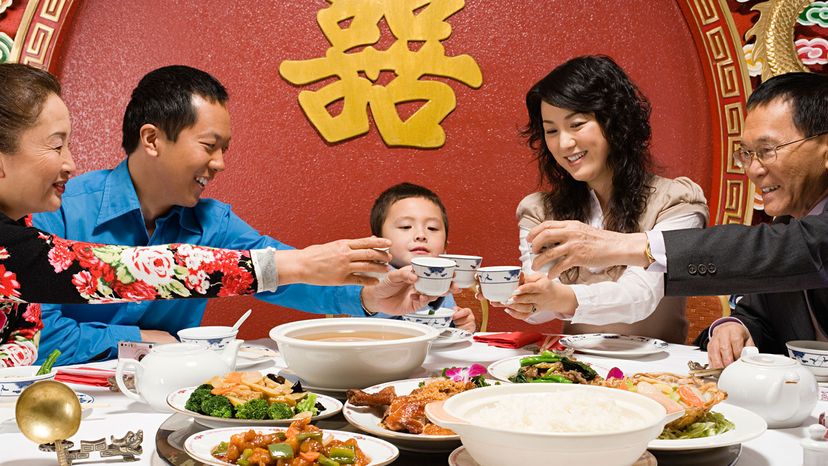
While folks in the West traditionally welcome the New Year by drinking champagne and maybe eating black-eyed peas and greens for luck and wealth, the Chinese emphasize feasting and mark New Year's Eve with a large dinner, which typically includes items like dumplings, prawns, dried oysters and other types of seafood. This was traditionally a home-cooked meal, but today more families celebrate at restaurants, which is why New Year's Eve reservations at good restaurants in China can be hard to come by. Families might also hire a professional chef to cook their meal at home [source: History.com].
Many of the foods associated with New Year have symbolic meaning attached to them. For example, oranges, melons and kumquats are popular because their gold color suggests wealth. Dumplings are fashioned to resemble gold and silver ingots and served in soup as symbols of riches. Hard-boiled eggs, cellophane noodles, fish and chicken are all associated with prosperity. Long noodles represent longevity, and the Chinese eat them whole -- it's said that cutting them up in the bowl might lead to a short life. Since red is also so much associated with the New Year, it also features heavily in celebratory dishes. Red dates, red-dyed pumpkin seeds and pomegranates often appear on Chinese tables during this time of year.
On New Year's Day, some families eat a vegetarian meal in order to pay respect to the Buddhist precept of not killing animals and to gain longevity. One popular meat-free dish is jai, a stew that includes ginkgo nuts, black moss, bean curd, bamboo shoots, noodles and scallions, all foods associated with good luck. For dessert, oranges and Chinese New Year cake appear [source: Family Culture].
On the seventh day of the New Year, the Universal Birthday, a colorful, tossed raw fish salad serves as a symbol of longevity and good luck. On the 13th, a simple cleansing meal of rice and greens is advised to take a break from all the feasting. For Lantern Festival at the end of the New Year celebration period, the Chinese eat a soup containing balls of glutinous rice. These dumplings represent the full moon and perfection and like many other New Year foods, are intended to bring good luck. Popular snacks throughout the period include peanuts and mandarin oranges. A circular tray containing sweets and nuts, known as the "Tray of Togetherness," is also a favorite [source: nationsonline.org].
There are many other traditional ways to celebrate Chinese New Year. Read on to find out about the most popular ones.
Sounds Like
Some foods have become popular New Year dishes simply because their names in Chinese sound like auspicious words. For example, the word for a type of dried seaweed, cai, sounds like the Chinese word for "fortune." The word yu, meaning fish, sounds like the word for "abundance." Oyster, hao, sounds like "good events." Eating these foods is thought to bring good luck [source: Welch].
As an avid enthusiast of Chinese culture, particularly its rich culinary traditions associated with celebrations, I bring a wealth of firsthand knowledge and a deep understanding of the symbolic meanings behind various dishes during the Chinese New Year festivities. I've explored the roots of these traditions, delving into historical contexts and cultural significance, making me well-equipped to shed light on the concepts embedded in the article.
The Chinese New Year, also known as the Spring Festival, is a momentous occasion marked by unique culinary practices. The emphasis on feasting during the New Year's Eve dinner is a significant aspect, with families traditionally preparing a home-cooked meal. However, the contemporary trend of celebrating at restaurants or hiring professional chefs showcases the evolving nature of these customs.
The variety of foods consumed during the Chinese New Year is not arbitrary; each dish carries symbolic meaning. Oranges, melons, and kumquats, for instance, are chosen for their gold color, symbolizing wealth. Dumplings, shaped like gold and silver ingots and served in soup, represent riches. Eggs, cellophane noodles, fish, and chicken are associated with prosperity, while long noodles symbolize longevity. The color red, closely tied to the New Year, is prominently featured in celebratory dishes, such as red dates, red-dyed pumpkin seeds, and pomegranates.
On New Year's Day, some families observe a vegetarian meal, aligning with Buddhist principles of non-violence and aiming for longevity. Jai, a meat-free stew containing ginkgo nuts, black moss, bean curd, bamboo shoots, noodles, and scallions, is a popular choice. Oranges and Chinese New Year cake often conclude the meal.
The seventh day, known as the Universal Birthday, involves a colorful raw fish salad symbolizing longevity and good luck. The 13th day suggests a simpler meal of rice and greens to take a break from the festive feasting. Lantern Festival, marking the end of the New Year celebrations, features a soup with glutinous rice dumplings representing the full moon and perfection, symbolizing good luck.
Besides these specific dishes, various snacks play a role throughout the celebration, including peanuts and mandarin oranges. The "Tray of Togetherness," a circular tray with sweets and nuts, is a favorite during this period.
Additionally, the article mentions that some foods have become popular due to their auspicious-sounding names in Chinese. For instance, dried seaweed (cai) sounds like "fortune," fish (yu) sounds like "abundance," and oyster (hao) sounds like "good events." Consuming these foods is believed to attract good luck.
In essence, the Chinese New Year's culinary traditions are deeply rooted in symbolism, reflecting a blend of cultural beliefs, historical practices, and a desire for prosperity and longevity.